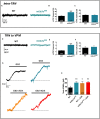Phasic and Tonic mGlu7 Receptor Activity Modulates the Thalamocortical Network
- PMID: 27199672
- PMCID: PMC4842779
- DOI: 10.3389/fncir.2016.00031
Phasic and Tonic mGlu7 Receptor Activity Modulates the Thalamocortical Network
Abstract
Mutation of the metabotropic glutamate receptor type 7 (mGlu7) induces absence-like epileptic seizures, but its precise role in the somatosensory thalamocortical network remains unknown. By combining electrophysiological recordings, optogenetics, and pharmacology, we dissected the contribution of the mGlu7 receptor at mouse thalamic synapses. We found that mGlu7 is functionally expressed at both glutamatergic and GABAergic synapses, where it can inhibit neurotransmission and regulate short-term plasticity. These effects depend on the PDZ-ligand of the receptor, as they are lost in mutant mice. Interestingly, the very low affinity of mGlu7 receptors for glutamate raises the question of how it can be activated, namely at GABAergic synapses and in basal conditions. Inactivation of the receptor activity with the mGlu7 negative allosteric modulator (NAM), ADX71743, enhances thalamic synaptic transmission. In vivo administration of the NAM induces a lethargic state with spindle and/or spike-and-wave discharges accompanied by a behavioral arrest typical of absence epileptic seizures. This provides evidence for mGlu7 receptor-mediated tonic modulation of a physiological function in vivo preventing synchronous and potentially pathological oscillations.
Keywords: EEG; epilepsy; glutamate; short-term plasticity; thalamic network.
Figures










Similar articles
-
Modulation of short-term plasticity in the corticothalamic circuit by group III metabotropic glutamate receptors.J Neurosci. 2014 Jan 8;34(2):675-87. doi: 10.1523/JNEUROSCI.1477-13.2014. J Neurosci. 2014. PMID: 24403165 Free PMC article.
-
Developmentally regulated neurosteroid synthesis enhances GABAergic neurotransmission in mouse thalamocortical neurones.J Physiol. 2015 Jan 1;593(1):267-84. doi: 10.1113/jphysiol.2014.280263. Epub 2014 Dec 3. J Physiol. 2015. PMID: 25556800 Free PMC article.
-
Identification of positive allosteric modulators VU0155094 (ML397) and VU0422288 (ML396) reveals new insights into the biology of metabotropic glutamate receptor 7.ACS Chem Neurosci. 2014 Dec 17;5(12):1221-37. doi: 10.1021/cn500153z. Epub 2014 Oct 9. ACS Chem Neurosci. 2014. PMID: 25225882 Free PMC article.
-
Metabotropic glutamate receptors in the thalamocortical network: strategic targets for the treatment of absence epilepsy.Epilepsia. 2011 Jul;52(7):1211-22. doi: 10.1111/j.1528-1167.2011.03082.x. Epub 2011 May 13. Epilepsia. 2011. PMID: 21569017 Review.
-
The mGlu7 receptor in schizophrenia - An update and future perspectives.Pharmacol Biochem Behav. 2022 Jul;218:173430. doi: 10.1016/j.pbb.2022.173430. Epub 2022 Jul 21. Pharmacol Biochem Behav. 2022. PMID: 35870668 Review.
Cited by
-
Thalamocortical circuits in generalized epilepsy: Pathophysiologic mechanisms and therapeutic targets.Neurobiol Dis. 2023 Jun 1;181:106094. doi: 10.1016/j.nbd.2023.106094. Epub 2023 Mar 27. Neurobiol Dis. 2023. PMID: 36990364 Free PMC article. Review.
-
Development and profiling of mGlu7 NAMs with a range of saturable inhibition of agonist responses in vitro.Bioorg Med Chem Lett. 2022 Oct 15;74:128923. doi: 10.1016/j.bmcl.2022.128923. Epub 2022 Aug 6. Bioorg Med Chem Lett. 2022. PMID: 35944850 Free PMC article.
-
Targeting metabotropic glutamate receptors for novel treatments of schizophrenia.Mol Brain. 2017 Apr 26;10(1):15. doi: 10.1186/s13041-017-0293-z. Mol Brain. 2017. PMID: 28446243 Free PMC article. Review.
-
GRM7 gene mutations and consequences for neurodevelopment.Pharmacol Biochem Behav. 2023 Apr;225:173546. doi: 10.1016/j.pbb.2023.173546. Epub 2023 Mar 30. Pharmacol Biochem Behav. 2023. PMID: 37003303 Free PMC article. Review.
-
The role of thalamic group II mGlu receptors in health and disease.Neuronal Signal. 2022 Nov 15;6(4):NS20210058. doi: 10.1042/NS20210058. eCollection 2022 Dec. Neuronal Signal. 2022. PMID: 36561092 Free PMC article. Review.
References
-
- Berridge M. J., Taylor C. (1988). “Inositol trisphosphate and calcium signaling,” in Proceedings of the Cold Spring Harbor Symposia on Quantitative Biology (Cold Spring Harbor, NY: Cold Spring Harbor Laboratory; ), 927–933. - PubMed
-
- Bertaso F., Lill Y., Airas J. M., Espeut J., Blahos J., Bockaert J., et al. (2006). MacMARCKS interacts with the metabotropic glutamate receptor type 7 and modulates G protein-mediated constitutive inhibition of calcium channels. J. Neurochem. 99 288–298. 10.1111/j.1471-4159.2006.04121.x - DOI - PubMed
Publication types
MeSH terms
Substances
LinkOut - more resources
Full Text Sources
Other Literature Sources

